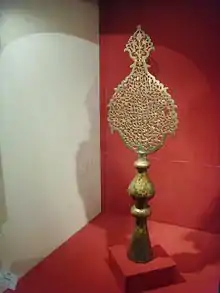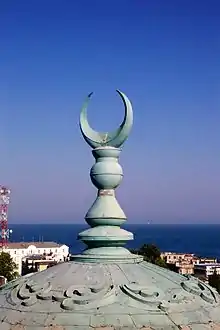Alem (finial)
An Alem (Arabic: أليم, Turkish: Alem) is a type of metal finial. Although the terms used are somewhat fluid, in Ottoman Turkish, the word alem means a military banner consisting of a tall pole (sap) with a silk flag or banner (sancak) topped by a metal finial (saifa). In modern Turkish, sancak can apply to the whole standard and not simply the fabric of the banner. The word alem came to be applied to the decoration at the top of the flagpole.[1] The central Asian tugh with yak or horse hair (instead of a flag) can also be topped by an alem.


One or more metal protective cases or boxes (muhafazas)—often octagonal—containing a diminutive copy of the Qur'an were attached below the alem by a cord or chain.[2]
After the rise of Islam (and especially after the fall of Constantinople to the Ottomans in 1453) the word alem also came to be applied to the architectural device which caps a minaret, dome of a mosque or minber (pulpit). It may incorporate an Islamic emblem of the crescent (with star), a tulip or other shape.
Miniatures from the Seljuk era show gilded finials on top of tentpoles.

See also
References
- Citations
- Coffey 2010, pp. 81, 109-10.
- Coffey 2010, pp. 81-82.
- Sources
- Coffey, Heather (2010). "Between Amulet and Devotion: Islamic Miniature Books in the Lilly Library". In Gruber, Christiane J. (ed.). The Islamic Manuscript Tradition: Ten Centuries of Book Arts in Indiana University Collections. Indiana University Press. ISBN 9780253353771.CS1 maint: ref=harv (link)
External links
- Turkish alem makers. Anadolujet. Retrieved 15 May 2015
- Ottoman flag finials